![]()
![]()
![]()
Use LEFT and RIGHT arrow keys to navigate between flashcards;
Use UP and DOWN arrow keys to flip the card;
H to show hint;
A reads text to speech;
25 Cards in this Set
- Front
- Back
- 3rd side (hint)
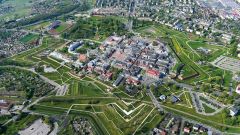
|
Zamosc (Poland), Bernardo Morando and others, founded 1580 |
-ideal/utopian city, promoted by church and state alike, fall of feudalism caused many to move to cities, couldn't tear down an existing city, so most projects didn't come to fruition -churches/temples/mosques for every religion, and the town hall was at the center, equality -standardized arcades, but left room for individualism in the upper storeys |
|
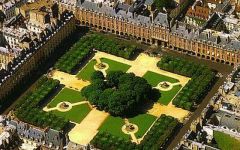
|
Place des Vosges, Baptiste du Cerceau, Paris, 1605-12 |
-for Henry IV, a place where he could be with the people, didn't actually live here, unified façades and no trees to block the view, statue in the middle of Louis XIII (Henry assassinated) -re-glorifying Paris, promoting french economy by putting in merchant shops and affordable appartments, ideally wanted to mix the poor and the wealthy, but the silk industry went bankrupt and the wealthy bought up all of the appartments |
|
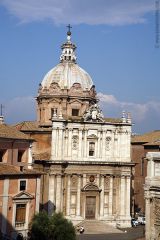
|
SS Martina e Luca, Pietro da Cortona, Rome, 1635-50 |
-curves create a breathing building, pushing in and out, alive, tricking the eye using giant order -academy of S. Luke (patron saint of the arts), Cortona was the head, merged with the church, found the remains of S. Martina and used them to draw in visitors and the pope |
|
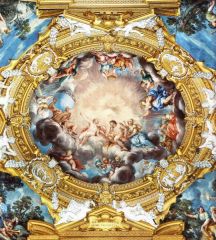
|
Hall of Apollo (ceiling), Pietro da Cortona, Palazzo Pitti, 1647 |
-frames in secular spaces contained the frescoes, paintings knew their place, no longer trying to convert -apotheosis, heaven opening up, pagan-ized religious imagery |
|
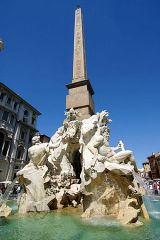
|
Fountain of the Four Rivers, Gianlorenzo Bernini, Rome, 1648-51 |
-important that the viewer looks at the piece in the round; opening and closing of space, natural grottoes, but can't hold up that much weight, figures becoming more agitated, in motion; like a filmstrip -four rivers represented the four corners of the world, through them bringing Catholicism to the world; exotica; Danube reached the heretics in Europe, Ganges, Nile, Rio de la Plata |
|
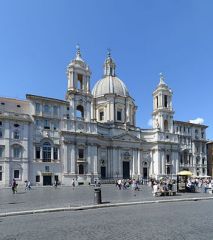
|
Façade of S Agnese in Agone, Francesco Borromini, Rome, begun 1653 |
-patron: Pope Innocent X Pamphilj, promoted art to outlive them, modelled after St. Peter's, statement of papacy, no room for a square, so pulls the façade back to create a spilling staircase -façade extends farther than the nave of the church, illusion of grandeur, dome moved forward so that it shows, correcting the faults of St. Peter's |
|
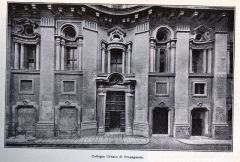
|
Collegio di Propaganda Fide, Francesco Borromini, Rome, 1654-67 |
-because of the size of the street, the building is advertised from the sides, bulging out and dominating the street, canted pilasters and windows -Borromini doing his own thing, barely any wall left, invents the order, random architectural elements, as sculptural as he gets -"College of the Propagation of the Faith", headquarters for missionary work |
|
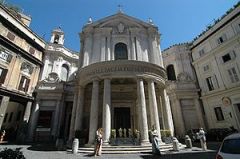
|
Façade of S Maria della Pace, Pietro da Cortona, Rome, 1656-8 |
-goes out of his way to welcome you in; carved out trapezoidal space, add the large portico, other buildings push back -theater-like, audience instead of pedestrian, fake boxes, actually part of the other buildings |
|
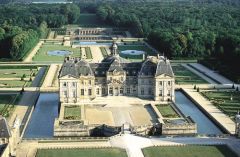
|
Château of Vaux-le-Vicomte, Louis le Vau and others, 1657-61 |
-Louis the XIV stole it and the design for Versailles -on a pedestal, removed from the other buildings -rectilinear, french hated Borromini, oval on the south side, with a dome, hidden from front, transitional space between the garden and the inside, Baroque surprise |
|

|
King's Bedroom, Château of Vaux-le-Vicomte, Louis le Vau, Charles le Brun, and others, France, 1657-61 |
-symbol of fidelity to the monarch, he never really slept here, semi-public, observed sleeping; reminder of his power and semi-divine status, absolutism -french style is simple and clean, frescos only on the ceiling, paintings in frames, simple iconography -fresco: truth supported by time |
|
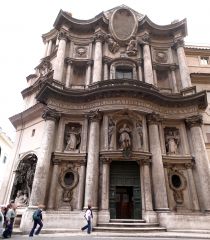
|
Façade of San Quattro alle Fontane, Franceso Borromini, 1665-7 |
-ultimate false façade; concave and convex shapes make it breathe, giant order for size, looks like four storeys when it's only two -challenging the very stability of architecture |
|

|
Château of Versailles, Louis le Vau and others, 1668-71 |
-matched the ego of its patron -intimidating, wings stretch out to the city, power, opposite effect of St. Peter's, patte d'oie -envelopes his father's original hunting lodge, many different phases with different styles -king's bedroom aligned perfectly with the rising and setting of the sun on the eqiunox, Sun King, Apollo, ego -gold standard for french architecture on the garden side: rusticated base floor, ornamented first floor, simple attic, then a balustrade |
|
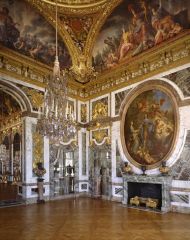
|
Salon de la Guerre, Versailles, Jules Hardouin-Mansart and Charles le Brun, 1678-86 |
-sense of desperation, needs backing, losing wars, people revolting, end of his reign -classical style, marble, glory of Ancient Rome, while showing scenes of real battles -liberal arts shown as well, Apollo played the harp -equestrian portrait, stable, in control; didn't like Bernini's because of the movement, unstable |
|

|
La Gallerie des Glaces (Hall of Mirrors), Versailles, Jules Hardouin-Mansart and Charles le Brun, 1678-86 |
-was only a corridor, served no other purpose, used to be the king's garden -episodic ceiling, victories in real time and some allegorical images, also false architecture to lighten the vault -center fresco, Louis in a chariot, like Apollo, Roman details in battle scenes |
|
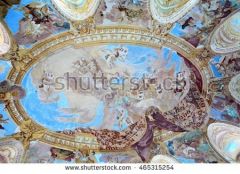
|
Ceiling of the Great Hall, Vranov Castle, Johann Bernhard Fischer von Erlach and Johann Michael Rottmayr, 1690-7 |
-Louis' style was copied, heavy frames, apotheosis, chariot, hair, shirtless, legs, false marble walls |
|
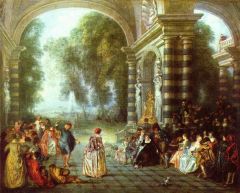
|
The Pleasures of the Ball, Antoine Watteau, 1715-7 |
|
|

|
Pilgrimage to Cythera, Antoine Watteau, 1717 |
|
|
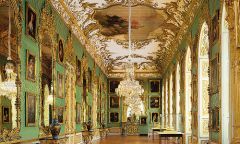
|
Green Gallery, François de Cuvilliés, stucco by Johann Baptist Zimmermann, Munich Residenz, Germany, 1730-37 |
-spread of the Rococo style to Bavaria, used indoors as well as outdoors -non-narrative figures in the stucco work -Versailles-like |
|
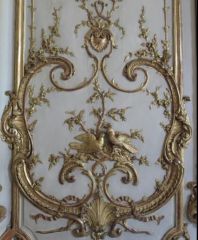
|
Boiseries in the Salon Blanc at the Hôtel de Roquelaure, Nicolas Pineau, Paris, 1733 |
-emphasis on the frame, nothing narrative, all about aesthetic -s curve -not symmetrical!! only in the mid-Rococo/genre pittoresque |
|

|
Circular Salon (Hall of Mirrors), François de Cuvilliés, Amalienburg Pavillion, Germany, 1734-49 |
-Bavarian flag colours -escapist, garden feel, inside out, retreat |
|
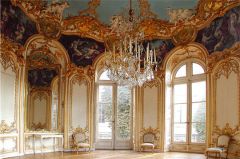
|
Salon de la Princesse, Germain Boffrand, Hôtel de Soubisse, Paris, 1738-40 |
-coves are adorned with canvas paintings of cupid and psyche, compete for attention with the gilding -animated puti to draw attention to the ceiling, not narrative -mirrors reflect the ornamentation, all about the aesthetic |
|
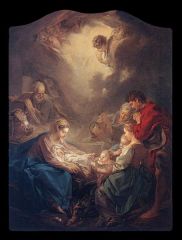
|
The Light of the World, François Broucher, 1750 |
|
|
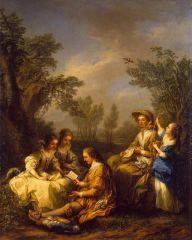
|
Spanish Reading, Carle van Loo, 1754-5 |
-for Mme Geoffrin, culture and values of the salon, relaxed, not rigid, literature, female presence, salonière, protegé, keeping passions under control -culture of politesse |
|
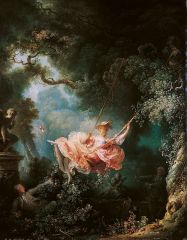
|
The Swing, Jean-Honoré Fragonard, 1767 |
|
|
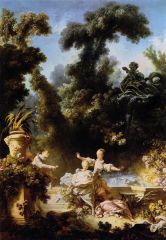
|
The Pursuit, Jean-Honoré Fragonard, 1771 |
|

